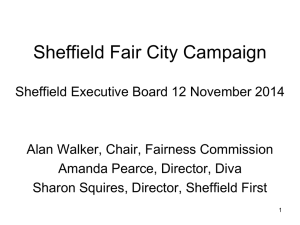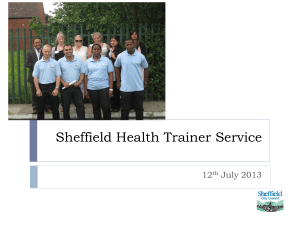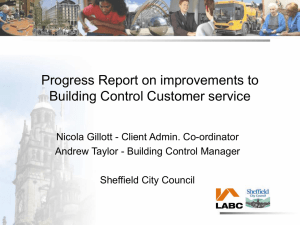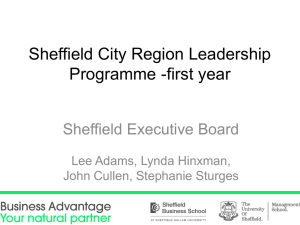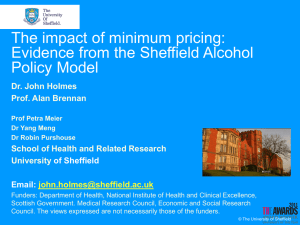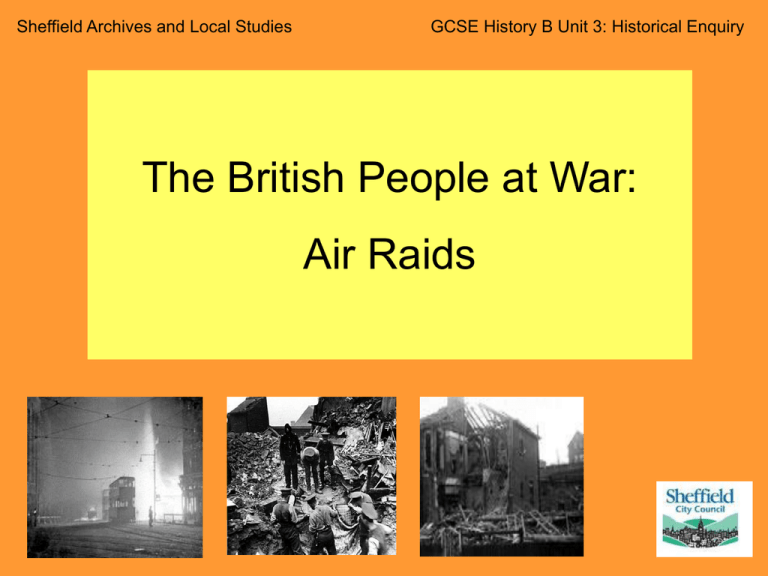
Sheffield Archives and Local Studies
GCSE History B Unit 3: Historical Enquiry
The British People at War:
Air Raids
Why Was Sheffield a Target in World
War One?
•
During the First World War, by mid1915, there was an acute shortage of
munitions and weapons for the war.
•
The Munitions of War Act gave
munitions factories and related
industries priority over other work and
production lines were switched to
produce munitions.
•
•
Sheffield’s strong industrial base
meant that there was a heavy
concentration of armaments industries
in the city and many Sheffield factories
played a key part in the war effort.
It also meant that it was a target for
German forces attempting to cut off
production and thus supply to the
British front lines.
Soldier’s body shield
and helmets showing
results of shrapnel
bullet tests. Both
manufactured by
Hadfield Ltd,
Sheffield, 1916
(Sheffield Archives: Ref.
HAD box 57)
Munitions Manufacture,
Sheffield Simplex Motor
Works Ltd. Fitzwilliam
Works, Tinsley.
(Picture Sheffield: s02070
Zeppelins
•
Zeppelins had been used for
commercial flights prior to the
outbreak of war but Germany
began to use Zeppelins for military
purposes including
reconnaissance and bombing
missions.
•
The first German Zeppelin attack
on Britain was in January 1915.
•
Sheffield suffered its first and only
Zeppelin attack on the evening of
25th/26th September 1916.
Zeppelin similar to the L-22 which undertook
the air raid on Sheffield in 1916.
(Reproduced by permission of Mark Goodwill. Image
from www.brigantian.force9.co.uk/gallery.html)
The L-22 was 178.5 meters long with a
maximum diameter of 18.7 meters. It
could accelerate to a top speed of 60
mph.
Zeppelins
What is a Zeppelin?
• A rigid skeleton made of metal,
usually duralumin or aluminium
• Gasbag of cells filled with gas
such as helium or hydrogen
made of sheets of prepared
cattle intestine or later, cotton.
• Moved by internal combustion
engines.
• Steered by several fins
Zeppelin LZ-129 Hindenburg shortly after catching fire on May
6, 1937 at Lakehurst Naval Air Station, USA.
Discussion:
What are some of the benefits and
drawbacks of the Zeppelin?
Zeppelin Attack on Sheffield
•
The air raid buzzers around the city sounded at approximately 10:30pm on Monday
25th September to warn people of the impending approach of the Zeppelin.
•
Many people took cover but not everyone heeded the warning, believing that
Sheffield’s inland position and the surrounding hills would make it a hard target for
any night attacks. This was Sheffield’s 14th air raid warning (Sheffield was to have
over 23 air raid warnings during the war) but this time, the threat was very real.
•
A Zeppelin, (the L-22) arrived over the city just after midnight.
•
It flew across the city to the Fulwood and Redmires areas and then turned towards
Attercliffe.
•
It dropped the first of its bombs at approximately 12:25am on 26th September.
Zeppelin Attack on Sheffield
The Zeppelin dropped high
explosive bombs on several
residential streets:
Danville Street
Grimesthorpe Road
Petre Street
Writtle Street (now Maxwell
Way)
Cossey Road
Corby Street (now Fred
Mulley Road)
Woodbourne Hill Road
It also dropped several
bombs near Burngreave
Cemetery, Manor Lane,
Darnall and Tinsley colliery
but these did little or no
damage.
Discussion:
What do you notice about the
areas that were bombed?
How many people do you
think were killed?
Map data © 2011 Google
Reporting the Attack
• Due to National Security, the press were often very vague about the
exact location of air raids. A local paper the Yorkshire Telegraph and
Star ran a report the day after the raids.
“About fifteen bombs were
dropped soon after midnight on
a North Midland County. It was a
calm night with hardly a breath
of wind, but was overcast with
stars only occasionally showing.
The Zeppelin came from the
North. Several small houses
were wrecked and many had
their windows and doors
severely damaged….”
Sheffield Star, Tuesday 26th Sep 1916
(Sheffield Local Studies: microfilm)
Personal Experiences
Below is an extract from a letter written by a resident of the Highfields area of
Sheffield.
‘… we had a Zepp Raid on Monday… we sat at my bedroom window
and about 12 o’clock we saw a great red flare go across the sky and a
second later a terrific crash then another. They were high explosive
shells and they shook the earth. The damage is at Pitsmoor and
Attercliffe districts right among the works… the havoc among the poor
slum houses is awful, one street, Cossey Street, four houses were
completely demolished and all the inmates buried. When I [saw] it early
in the morning they had recovered 14 bodies but later in the day they
brought a baby boy of about 3 years out alive and conscious!’
Part of a letter written by a resident of Highfields,
Sheffield, 1916 describing the Zeppelin raid over
Sheffield
(Sheffield Archives: Ref. MD7126)
After the Attack
• Reports which appear several days after give more
details of the casualties which were a result of the attack.
• 18 high explosive bombs were dropped
• 18 incendiary bombs were dropped
• Serious damage was done to 89 houses, one hotel and
one chapel.
• 150 houses were less seriously damaged
• 28 people were killed
Photograph shows rescuers
searching the wreckage at Cossey
Road, Burngreave after the air raid
(Picture Sheffield: s00146)
Casualties
• A list of those killed in the Air Raid appeared in the
newspaper but much later.
• Memorials were erected to remember those who died.
Discussion:
What do you notice about the ages and
sex of the casualties?
Report of deaths and
damage caused by
Zeppelin raids in the
Sheffield Star, 4th Dec
1918.
(Sheffield Local Studies:
microfilm)
Plaque commemorating those who lost their
life in the 1916 Zeppelin raid.
(Picture Sheffield: s22338 )
Why Was Sheffield A Target in
World War Two?
Finished 16 inch Gun
Barrels, Gun Shop
Examination Bay, Vickers
Ltd., River Don Works
•
During the Second World War,
Sheffield’s factories once again were
heavily involved in the production of
armaments.
•
As before, this made the industrial part
of the city a prime target for Hitler’s
forces.
•
Hitler’s plan was to bomb the major
cities, cutting off the production and
making the British people panic,
forcing the country’s surrender.
•
This period of bombing was know as
‘The Blitz’. The word comes from the
German 'blitzkrieg', which means
'lightning war'.
(Picture Sheffield: s10742 )
Core Moulds for Tallboy
(10 ton) and Grand Slam
(5 ton) Bombs
(Picture Sheffield: u04016 )
Civil Defence
•
•
•
The Government and people were more prepared during World War II for aerial raids.
Lots of people had special shelters in their gardens. There were also Air Raid
Precaution (ARP) wardens who would take charge during an air raid and make sure
people got to safety.
There were anti aircraft guns and barrage balloons around Sheffield to try and head
off aerial attacks.
R.A.F. barrage balloon on
Crookesmoor Recreation
Ground
(Picture Sheffield: s03559 )
ARP
magazine
(Sheffield Local
Studies Library:
Ref. 623.3 S)
The Sheffield Blitz
• The main attacks on Sheffield took place on the nights of
12/13th and 15/16th December 1940.
• On 12th December over 330 German aircraft are
believed to have attacked the city.
• Two nights later the bombers returned and 90 enemy
aircraft attacked the city.
High Street in Flames, World War II
(Picture Sheffield: s00275 )
Sheffield Blitz – Nazi Plans
• Documents now held at Sheffield Archives and Local
Studies Library show the Nazi’s plans
The document above is a translation
showing how many planes were due
to bomb Sheffield and at what time.
(Sheffield Local Studies Library: Blitz
Education Folder)
This document is in
German and
describes the exact
location of Rixon
Woodhouse, a
factory involved in
the war effort. The
area to be bombed
was highlighted in
red on the
accompanying map
(Sheffield Archives:
Ref: X196)
Sheffield Blitz – The First Attack
•
As in the First World War, the air raids sounded and people attempted to take cover.
•
On 12th December over 330 German aircraft attacked but the industrial east of the
city was largely defended by fog so again, as when the Zeppelins attacked, the
bombs landed in more residential areas.
•
Areas hit included Norton Lees, Gleadless, Abbeydale, Brincliffe Edge, Moorhead,
Glossop Road, Park Hill, Millhouses, Sharrow, Broomhill, Crookesmoor, Walkley,
Owlerton, Burngreave, Meersbrook, Wybourn and Neepsend.
•
The Moor was devastated and every building on Angel Street was bombed or firedamaged.
•
Nether Edge Hospital and Jessops Hospital suffered direct hits and 106 out of 154
Sheffield schools were damaged (8 destroyed).
Many people took cover in air
raid shelters, known as
Anderson shelters. These were
half buried in the ground and
often were put in people’s back
gardens.
(Picture Sheffield: s02365 and s02045 )
Sheffield Blitz
Images from www.picturesheffield.com showing
Sheffield burning after the raiders dropped their
bombs.
(Picture Sheffield (from left to right): s01282, s01204, s01135, and s01157 )
Sheffield Blitz – The Second Attack
• 2 nights later, 90 enemy aircraft attacked.
• This time the industrial east of the city was hit - Attercliffe,
Grimesthorpe and Burngreave in particular.
• Most of the major munitions and armament factories were not badly
damaged and very few actually lost any time in closing for repairs
Photographs showing
the damage inflicted by
the air raids.
(Picture Sheffield (from left to
right): s01056 and s01166)
Sheffield Blitz - After the Attack
• Almost 700 people killed during these 2 air raids.
• Over 82,000 houses damaged.
• Well-known buildings badly damaged/destroyed included Kings
Head Hotel, Angel Hotel, Atkinson’s Department Store, C & A
Modes, St Mark’s church, St Vincent’s Roman Catholic church, the
Central Hebrew Synagogue, Sheffield United Football Club’s
Bramall Lane ground and the Athenaeum Club.
Photographs show C&A
Modes and the Marples
Hotel after the Blitz, and
Bramall Lane Football
Ground.
(Picture Sheffield (from left to right:
s02106 and s01013 )
Sheffield Blitz – The Marples Hotel
•
Single biggest loss of life took place in the Marples Hotel, on corner of Fitzalan
Square/ High Street.
•
On night of 12 December 1940, over 70 people were sheltering in the cellar there.
•
At 11.44 pm the building received a direct hit from a high explosive bomb and all 7
storeys collapsed down onto the cellars .
•
Only 7 survived.
Photograph shows the
rescue of a survivor from
the Marples Hotel, the
morning after the Blitz.
(Picture Sheffield: s02104 )
Sheffield Blitz
• People had many different experiences of the Blitz
“After the raid, my pal’s mother let us
lodge at their house and I remember
walking along Bridge Street with all my
surviving clothes on one hanger, to get
there. This was after a cup of tea at
Woodbourne Road School, with an
unexploded landmine for company.”
“I used to show off at being turned out
of a nice warm bed and then having to
try to sleep in the Anderson Shelter. I
would shout Mum “Oh leave me here to
die – I shan’t feel it!” Then Dad’s voice
would ring out and we all had to jump.”
“I just sat in the shelter doorway next to a
girl who was, like me, frightened. Next
thing was a big bang, then it was all hell.
All cried for help. The girl next to me died
– my foot hurt. There were about 8 of us
left. We sang Christmas carols until help
came.”
“Many unfortunate families, loathe to
leave their homes, preferred to sleep
under gaping holes with the stars for a
canopy. Wherever possible it was
“business as usual” along Staniforth
Road. Comradeship, unselfishness and a
wonderful neighbourliness was one
outstanding product resulting from the
Blitz.”
“I shall never forget the
laughter and applause I got
when I carried the landlady’s
clothes horse full of her
“smalls” down into the shelter
and plonked it down in front of
her.”
Letters sent to the Star
relating to memories of the
blitz, 1980
(Sheffield Local Studies Library:
Ref. 940.5442 SSTF)
“There was the
contents of all the
shop windows all on
the road. I looked up
at my flat and saw my
leaded windows
hanging out with
flames belching from
every window. I
realised with dismay
that my cat and
budgie must have
perished in the fire.”
“I crawled out and made my
way to the doorway just in
time to see Atkinson’s roof
collapse in flames … all the
time there was the ceaseless
drone of planes and balloons
falling in flames – I dashed
up the Moor past Woolworth’s
blazing away.”
Sheffield Blitz
Bomb Map
Sheffield Local Studies Library:
Ref. 940-5442SQ
The map shows
where bombs
were dropped
during both
nights of the
Blitz.
Discussion:
Compare the
number and
location of
bombs
dropped in the
Blitz to the
Zeppelin Raid.
What are the
main
differences?
Impact of Blitz
• Many people lost
everything, including their
homes.
• Many had to spend time
in rest centres which were
specially set up to care for
people who had lost their
homes.
• Almost 700 people were
killed over the two nights –
many more than were
killed in 1916.
Salvation Army mobile canteen after
air raids, Rest Centre - Re-clothing at
High Storrs School, Sorting household
salvage after air raid.
(Picture Sheffield (left to right) s01116, s02058
and s0118)
Blitz Statistics
(Sheffield Local Studies Library: Blitz
Education Folder)
Summary/Discussion
• Why did the Germans attack by air?
• What were the aims of the air raids? Were they
the same for both attacks?
• Think of the different air machines used in both
wars – what were the main differences and how
effective were they?
• Compare the aftermath of the Zeppelin Raid and
the Blitz
• Which raid would be considered the more
successful by enemy standards?

